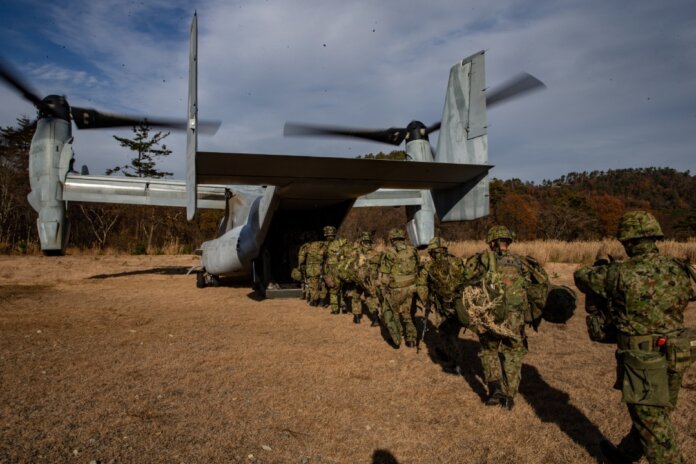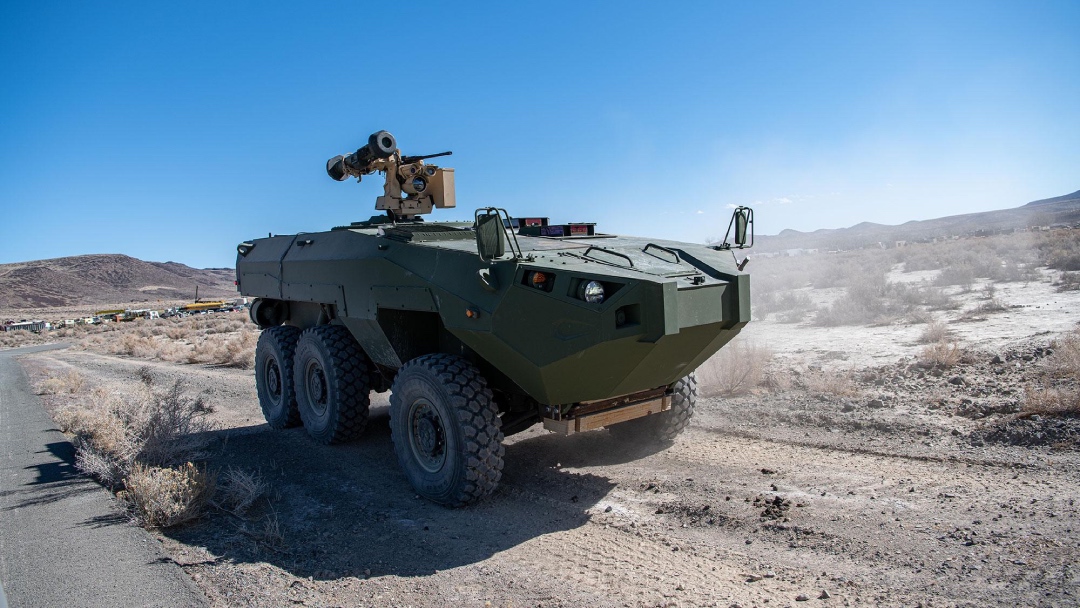
This month’s Commander’s Intent focuses on how the US Marine Corps senior command has updated its original Force Design 2030 concept (Mod 1), a revision that sets a direction away from the traditional role of the Corps since the Second World War.
Headquarters Marine Corps recently released the Commandant of the Marine Corps (CMC) David H. Berger’s Annual Report on the progress of its Force Design 2030. Unlike the prior Annual Report which was largely a reflection of the status of the changes being implemented, this Annual Report could be best described as Force Design2030 Mod 1. This report suggests it reflects the digestion of lessons learned from experiments, exercises, and comments from the Fleet Marine Forces. This Campaign of Learning, as it is described, has from the initial announcement of the FD2030 been offered as the means through which the concept would be validated and to identify opportunities for adaption of the direction of the Force Design efforts has it progressed. The update includes some further details on areas previously somewhat unclear, reconsiders some earlier force changes and lays out a number of restructuring and implementation options for additional study. It also seeks to layout a case that although focused on a shift to potential Pacific theatre conflict, the plan will still provide for an adequate ‘expeditionary crisis response force’.

FD2030 Update – Introduction
The May 2022 Annual Update begins by attempting to link the current restructuring to the concerns of, and efforts by, former Commandants to bring the Corps back to its naval amphibious roots and to take advantage of advanced technologies. This seems to seek legitimacy for concepts as well as approaching FD2030 in a post Iraq/Afghanistan context. This, and the repeated contention that FD2030 must retain its crisis response mandate, appears directed toward addressing some of the criticisms of the initial programme.
These have been particularly strong by over 30 retired Marine Corps General Officers including former Commandant’s like Gen Charles Krulak and Gen Joe Dunsford. Other critics are former Marines that previously held top Pentagon and command positions including James Webb (Secretary of the Navy), Gen James Mattis (Secretary of Defense), Gen John Kelly, and Gen Zinni. Still, the Update essentially remains committed to its bedrock principles of deploying “small but lethal forces…within a contested area as the leading edge of a defence-in-depth”. The intent is to rely on Stand-in-Force (SIF) insertions on uncontested forward sites. The SIF has been merged with and works within the longer standing Expeditionary Advanced Base Operations (EABO) doctrine.
Much of the discussion of the ‘Year in Review’ chronicles the various operational publications developed to support specific aspects of the doctrine execution. What stands out is the emphasis on conducting the Reconnaissance and Counter Reconnaissance (RXR) battle, which is critical to assuring not just the success, but the very survival of the disbursed SIFs. The recently activated 3d Marine Littoral Regiment (MLR) in Hawaii is to provide the testbed to ‘refine the design and inform further organisational change.
Key Demonstrations
The Update highlighted recent demonstrations of several systems that will be critical to the MLR’s capabilities to execute its primary mission. The Navy Marine Expeditionary Ship Interdiction System (NMESIS) – the adaption of the Kongsberg NASAMS attack missile (already used by the US Navy) to an Oshkosh unmanned joint light tactical vehicle (JLTV) referred to as Remotely Operated Ground Unit for Expeditionary (ROGUE) Fires, occurred in August 2021. In addition, a ground-launched Tomahawk surface attack missile was fired. These are key steps toward proving out the proposed anti-ship capability. The latter is also already programmed for a 2023 fielding by the US Army in its mid-range capability (MRC) batteries which will also be able to fire Raytheon SM-6 standard missiles. Another potential benchmark is the latest 6 May demonstration of the medium range intercept capability (MRIC), a derivative of the Israeli RAFAEL Iron Dome, in conjunction with Raytheon Missiles and Defense. The Iron Dome system is in limited Army service but was not selected following a shoot-off for its broader Indirect Fire Protection Capability (IFPS)Increment 2 programme. Instead it selected a system developed by the US firm Dynetics with fielding due in 2023. Both systems will counter sub-sonic cruise missiles, aircraft, unmanned aircraft, rockets and other aerial threats.

Issues and Actions
The Update highlights areas which have been identified as requiring ‘adjustments going forward. One of these is that ‘communications has not been effective with all stakeholders’. This suggests that attention to the SIF and MLR may not have been recognised in continuing to maintain the need for a global crisis response. It also reenforces the fact that the Marine Air Ground Task Force (MAGFT) remains “a reservoir of capabilities… to task organise” – a long tenet of Marine operational flexibility.
An observation from experimentation is that an over-emphasis on lethality neglected the critical importance of sensing and ‘the greater value of resilient sensing and enabling kill chains.” The infantry battalion structure, although continuing its refinement, appears to be settling at between 800 to 835 personnel. The artillery will now reflect seven tube batteries (against five proposed) of Lockheed Martin High Mobility Artillery Rocket System (HIMARS) multiple rocket launcher batteries. The proposed reduction was a key point of criticism – a point which might be reinforced by observations on the significant role cannon artillery has played in the conflict in Ukraine.
Marine Aviation’s reorganisation is addressed in a revision to the Bell/Boeing MV-22 medium lift helicopter squadrons (VMMs) upward to a total of 16 squadrons (against 14) but with a reduction in numbers as each of the new squadrons will have 10 aircraft instead of 12. This means a decrease in the total number of Marine MV-22s by 56 to 160 tiltrotors. This considering the Corps’ 2019 long-planned increase was to 18 active MV-22 squadrons with 12 aircraft in each. This equates to the loss of vertical assault capability of almost two infantry battalions overall. In fact, two medium lift squadrons have already been reactivated with a third scheduled in 2022. A rationale for the latest change was provided on 6 May briefing by Lt Gen Karsten Heckl, Deputy Commandant MCDEC, as being “primary a factor of personnel”. In essence, the Corps could not maintain sufficient pilots which has been a challenge for some time both in training new and retaining current company grade pilots. He further suggested that a 10 aircraft unit would open flight deck space for more Lockheed Martin F-35B attack aircraft in deployments, though these VMFA squadrons are also being down-sized. Many of the concerns over the impact of Marine Aviation reductions across the fleet include the Sikorsky CH-53K heavy lift helicopter, F-35B/C strike aircraft, and Bell AH-1Z/UH-1N. Gen Terry Drake (Ret), a former Assistant Commandant suggested that a comprehensive concept on how Marine air, particularly strike aircraft, will be employed and supported remains unclear.

Learning Points over the past years expressed in the Update have included a recognition that a “more balanced focus” of RXR and lethality will be required, with sensing and more rapid decision making (and targeting) of critical importance. The tenets of manoeuvre warfare are referenced in this aspect as well as the need for counter-reconnaissance. The need for deception is also touched on. The point is also made that SIFs must be logistically supported by capabilities suited for distributed operations over extended distances – challenges that remain without current solutions. Interestingly, the FD2030 Update appears to find the term MAGTF employed far more frequently than previous FD documents.
The ‘Concept for 21st Century Amphibious Operations’ document to be issued by 1 January 2023 may address how the SIF concept, which continues to be an emphasis of FD2030 actions, fits into the definition of “amphibious operations” in projecting power from the sea to the land.
Manoeuvre, Mobility and Fires
The Update continues to present the Light Amphibious Warship (LAW) as the primary maritime surface mobility asset of the SIF. It does, however, identify the need for other manned and unmanned vessels for reconnaissance, counter-reconnaissance, screening, small unit manoeuvre, and lethality to support sea control and denial. Experiments using LAW surrogates are expected to influence the final requirements for such a supporting vessel. However, the US Navy plan for acquiring the LAW remains uncertain and does not foresee an acquisition start before 2025 which might only provide vessels by July 2028 at earliest.
The report offers a more detailed mention of other manned and unmanned vessels within the Marine’s plan. The Long-Range Unmanned Surface Vessel, another Corps lead development, is referenced as an asset within the Marine Expeditionary Force (MEF). The Whiskey Project Next Generation Tactical Watercraft would appear to step-over into the Navy’s traditional area of responsibility. How or if this is being addressed is not covered in the Update.

For the first time, the Corps is questioning the base unit of its MLRs. Originally envisioned as an infantry battalion, it is now considering both the artillery and reconnaissance battalions as the base of the MLR. Considering the degree of transformation projected within the newly evolving MLRs, it is an interesting that this is being viewed as a concern. Questioning this might suggest the initial proposed structure of the MLR, who’s only artillery asset is a single anti-ship battery, may be being reconsidered?
The Light Armoured Reconnaissance (LAR), which was earmarked in the initial concept for a significant expansion to 12 companies, is being viewed as a broader ‘reconnaissance’ asset. “Sole reliance on armoured ground vehicles is too limiting,” so experiments exploring a maritime reconnaissance/counter-reconnaissance capability are to be conducted. The stated objective is toward forming ‘Mobile Reconnaissance Battalions’. This will influence an update to the Corps Ground Combat Tactical Vehicle Strategy including both the current Amphibious Combat Vehicle (ACV-30) armed with a 30mm auto-cannon and the Advanced Reconnaissance Vehicle (ARV) which is in prototype stage. Basing this LAR review on the apparent contention that “ground vehicle concentric approaches” are somehow problematic opens, at least, the question of how one achieves both sensor mobility (i.e., integrating UAS and other sensors) and enhance organic LAR lethality as is also proposed in the Update. Further, as currently organised with a family of mission variants, the LAR remains the sole mobile tactical ground manoeuvre force. The implications of a possible shift to a strictly mobile reconnaissance role remain to be seen.

The Update reinforces the aim to enhance small unit organic firepower, noting that field experiments have demonstrated their ability to significantly shorten the detect-decide-engage cycle, thereby increasing their lethality and demoralising impact. Systems such as the light miniature attack munitions (LMAMs) and multi-purpose anti-armor anti-personnel weapon system (MAAWS) are improving the combat efficiency of these units.
The Update further directs exploration into other lethality enhancements like small swarming UAS, as well as identifying improvements in using assets including the sniper teams. However, particularly considering the significant tube artillery drawdown, the Update still lacks direction in to addressing the line company’s needs for improved indirect fires – with the reliance currently on the reallocation of two 81mm mortars to each infantry company.
In terms of Marine Aviation, beyond the VMM aircraft restructuring and the introduction of the Unmanned Aerial Refuelling System (MUX) and Medium Altitude Long Endurance (MALE) UAS, logistics seems a primary concern. The report surfaces the continued question over how aviation can be supported in a disbursed, large theatre of operations. This is a challenge that is paralleled with regard to support of SIF. Solutions include improved management, re-considering command relationships, and the formation of 18 multifunctional combat logistics battalions. The composition and capabilities of these Marine Logistic Groups (MLG) will need to include advanced base support, pioneers, and expeditionary medical. This effort is intended to be the subject of field experimentation.
The Corps focus will be on retaining more Marines for longer periods. It intends to highlight ‘hire to retire’ in its force over ‘recruit and replace’. This is partly driven by the desire to place more senior ranks in many positions within its organisation, particularly at the enlisted levels. This means both increasing first term enlistment retention and offering incentives for maintaining trained experienced Marines in the force. The challenge for this is clearly demonstrated by the issues already experienced in the Marine wings in keeping experienced air crews and maintainers.
Final Observations
Although the FD2030 Annual Update offers some clarifications and attempts to respond to some criticism, it may actually reinforce these concerns. While mentioning the MAGTF and ‘crisis response’, the Update offers little indication on how these roles and missions will be accommodated considering the nature of future conflict being hinted at in Ukraine. For example, although long range fires and precision munitions have a role to play, when massed locally controlled conventional cannon fires have been equally effective and dominant.
How the SIF and the ‘crisis response’ capabilities in a relatively small organisation are reconciled remains an open question. Further, there are other major challenges that are not discussed such as providing counter-air coverage including Counter-UAS for any Marine force action. In addition, as mentioned by outside observers, some key aspects of FD2030 are predicated on availability of capabilities that are neither in hand nor guaranteed – the LAW being one.
At a time when the Navy is seriously considering reducing the amphibious fleet, its lack of strong endorsement in the Update of the Corps’ future direction could damage efforts to retain and build ships. The report further reinforces the apparent direction that the SIF will apparently focus on conducting reconnaissance/counter-reconnaissance (screening) and providing targeting of maritime threats for long-range precision weapons – unquestionably defensive postures. The Update further hints at the depletion of offensive capabilities stating ‘our core competency is naval in nature. Heavy ground vehicles do not align with these priorities’. As stated by Gen Berger over two years ago: “We do not envision undertaking an operation entailing taking a hostile shore from the sea.” A proposition that remains evident in FD2030 is the proposal which to insert a force into uncontested sites. What remains unclear are a number of key pieces including how Marine air, especially attack air, a critical and unique combat enabler, fit into the vision. Finally, in the paragraph on Divestments, it suggests these decisions were based on whether “the mission is a Marine core competency and if another Service has a better (or equal?) capability”. If that deliniation of responsibility is pushed through in FD2030, it could result in an unfortunate and unwelcome twist to the revisioning.
by Stephen W. Miller












